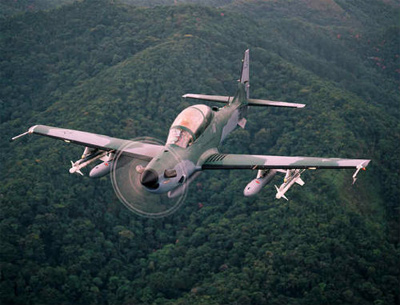 |
|
One kind of war plane on the Indonesia's procurement list |
Locating on the international maritime line through Malacca Strait connecting the Indian Ocean with the Pacific Ocean, Indonesia holds geo-strategic and geo-political importance. For this reason, Jakarta has always attached importance to modernizing its defence forces to maintain national security and territorial sovereignty.
According to Global FirePower, in 2014, Indonesia ranked 19 out of 106 countries in term of military strength. According to assessment of military analysts, this Southeast Asian nation is among the world top 35 military powers. To that end, Indonesia has gone through a number of stages of renovating and modernizing its military, including procuring, upgrading its weapon systems and equipment, and developing its own defence industry.
Speeding up the procurement of essential military equipment
In the recently announced defence renovation program, Indonesian president Joko Widodo committed to foster military professionalization through the renovation of troops’ welfare, improvement of weapon system, the increase of defence budget from 0.8% to 1.5% of GDP in the next 5 years. This signals a positive sign in the country’s roadmap to modernize its military. In reality, there has been a significant increase in Indonesian defence budget over the past 10 years from 1.7 billion USD in 2005 to nearly 7.8 billion USD in 2015. According to defence budget statistics announced by IHS Jane’s Defence Budget, the basic military budget of Indonesia increased by nearly 30% and can reach up to 11.5 billion USD in 2016 (with an annual increase of 9.4%). Budget for buying weapon and equipment increases by about 10.14% annually and focused on several main areas.
Developing domestic defence industry
One of the requirements set out by Indonesian government for its military modernization program is to increase its independence and reduce its dependence on external sources. So, increasing defence budget not only aims to upgrade its weapon systems and equipment but also to develop its own defence industry, creating a solid foundation for its military modernization. Accordingly, contracts for buying foreign weapons and equipment must include terms on manufacturing and assembling in Indonesia’s defence industry facilities. This is considered the foundation for Indonesia to develop its domestic defence industry. The Government of Indonesia also announced its “new livelihood for defence industry” program in 2009 with a view to make its industry more connected to the military and defence demands. This move aims to seek and mobilise all sources for defence industry and encourage foreign companies to transfer technology.
By doing this, Indonesia’s defence industry has gradually been set up and developed. The first significant product made by Indonesia is its assault rifle Pindad SS-1 model which is based on the FN FNC rifle with some modifications to suit the conditions of tropical climate. Basing on the Pindad SS-1 model, it developed Pindad SS-2 assault rifle which is considered a product of Indonesia not the one made under a foreign licence.
Promoting the achievements gained, Indonesia actively coordinates with the world major defence contractors in producing key military equipment. A notable one is CN-235 military transport plane - a joint product between CASA of Spain and Indonesian manufacturer Dirgantara. This is quite a successful transport plane for dual use purpose. Indonesia now has 3 CN-235 in its fleet. Through the joint production of the CN-235, Indonesia had chance to approach the advanced military aviation technology of Europe as CASA is a branch of the European Aeronautic Defence and Space Company (EADS). This cooperation created a solid foundation for Indonesia to grasp technologies for its future independent research. Indonesia become the first country in Southeast Asia to produce planes for its armed forces and export. Besides, the country also cooperates with South Korea to develop the fifth generation fighter under the KF-X/IF-X program. The total number of planes in this project is up to 250, of which Indonesia air force will receive 50, and the rest 200 belong to South Korea.
Indonesia is also creditable in the field of ship building in the region. Recently, this country has been able to build patrol boats, fast attack crafts with the ongoing project to build KRC-40 class fast attack crafts. In 2014, Indonesian Navy acquired and put in to operation its third, domestic-built missile ship KRI 643. This proves that Indonesia defence forces can strengthen its military power based on the capability of its domestic manufacturing, particularly through procuring contracts of advanced weapon systems from other countries which included terms of the transfer of technology. Indonesia is the only Southeast Asian country capable of building multi-role landing craft with displacement of over 10000 tons. Recently, Indonesia also had access to the technology to build non-nuclear submarines.
Indonesia’s defence industry also gained significant achievements in developing ground vehicles. Pindad APS-3 armoured personnel carrier is such a success story that can not be found anywhere else in Southeast Asia. Besides, Indonesia also exports some weapons and military equipment.
To conclude, starting from a low level of a developing country, Indonesia has combined procurement with joint-production and technology transfer to develop its own defence industry, gained major results. Todate, Indonesia has been capable of producing various key military weapons and equipment, such as: transport plane, fast attack craft, medium-landing ship, amoured vehicle, multiple launch rocket system, assault rifle, etc. Major manufacturers of Indonesian defence industry includes: PT Dirgantara specialized in aerial space industry; PT Pindad in army weapon systems, PT Pal in navy weapons and equipment, and PT Dahana in explosive charges). They are all regionally and world acclaimed. This is a success story for many countries in the region and the world to follow.
Colonel Dang Dong Tien